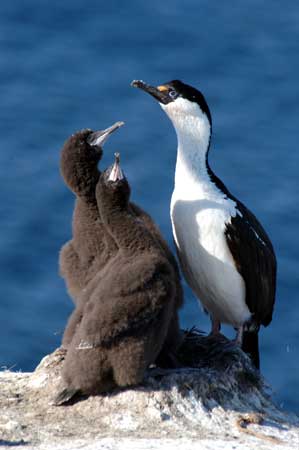
03 March 2007 | Position 55 49.5'S 67 30.7'W
01 March 2007 | Position 58 34'S 67 00'W
24 February 2007 | Position 64 19.5'S 62 55'W
22 February 2007 | Position 64 54'S 62 52'W
20 February 2007 | Position 64 49'S 63 30'W
20 February 2007 | Position 64 49'S 63 30'W
18 February 2007 | Position 65 06'S 64 04'W
16 February 2007 | Position 65 06'S 64 04'W
14 February 2007 | Position 65 26'S 65 22'W
11 February 2007 | Position 66 02'S 65 24'W
09 February 2007 | Position 66 02'S 65 24'W
06 February 2007 | Position 66 52'S 66 47'W
05 February 2007 | Position 66 02'S 65 24'W
04 February 2007 | Position 66 02'S 65 24'W
02 February 2007 | Position 65 08'S 64 02'W
28 January 2007 | Position 64 49'S 63 30'W
26 January 2007 | Position 64 49'S 63 30'W
25 January 2007 | Position 64 32'S 62 00'W
25 January 2007 | Position 64 32'S 62 00'W
24 January 2007 | Position 64 32'S 62 00'W
Imperial Shags
25 January 2007 | Position 64 32'S 62 00'W

We have spent 2 days at Enterprise Island enjoying the security of a well protected mooring spot. Within a mile of the boat numerous tiny islets are dotted about and we have done some exploring in the dinghy. We found many remains of open wooden whaling boats as this area was used extensively by the whalers. In the cold, dry air the wood has hardly begun to rot although these wrecks must be many decades old. Each island also has one or two pairs of nesting Antarctic skuas which are one of the scavengers of the region, preying on weak chicks, stealing eggs and feeding on dead birds. They cause panic in penguin colonies as they soar low overhead searching for opportunities but protect their own chicks viciously, making swooping attacks at any intruder. But the highlight of our time here has been a small colony of Imperial shags nesting on a rocky outcrop. We have spent hours each afternoon watching these fine looking birds hard at work bringing up their chicks. It was very interesting as with only 10 nests at this site, each seemed to be at a different stage in the breeding cycle. Some birds still had eggs and we saw the "changing of the guard" as one partner returned from sea with an offering of seaweed, used to build their nests, and after an elaborate greeting ritual of bill tapping, calling and graceful movement of their snake-like necks the sitting bird stepped out of the nest and the arriving bird moved on. Two pale green eggs were exposed for the briefest instant and seeing them was somehow very special, as if we had shared some great secret. Other birds had tiny chicks, scrawny looking in their minimal down, that were so new and vulnerable they needed constant warmth and protection. The remaining pairs had either one or two well grown chicks, grey and fluffy and almost too big to fit in the nest any more. The chicks cry endlessly for food making a strange noise like a squeaky bicycle pump and when a parent returns from fishing there is frantic excitement as the chick cranes its neck and pecks at the parent (see photo). This prompts it, eventually, to regurgitate a meal which is transferred to the chick in an uncomfortable looking process with the chick's head well inside the parent's throat....
Comments
| Vessel Name: | Wandering Albatross |
Gallery not available